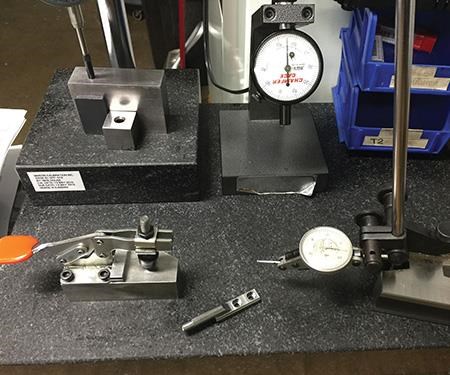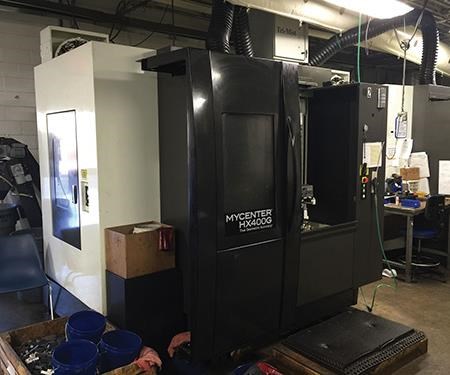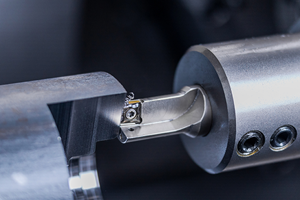Collet Chuck System Helps Produce AR Parts Efficiently
A collet chuck system from Horn USA Inc. helped firearm parts manufacturer Manufacturing Partners Inc. hit is productivity targets.
Share






Autodesk, Inc.
Featured Content
View More
Hwacheon Machinery America, Inc.
Featured Content
View More
While the latest economic downturn initially put Manufacturing Partners Inc. of Big Lake, Minnesota, into survival mode, it ultimately led the company to invest in the CNC machining side of its business. As orders increased, the firearm parts manufacturer needed to improve efficiency and accuracy as well as reduce cost per part. Focusing on improving its tool-clamping process and acquiring a new collet chuck system from Horn USA Inc. of Franklin, Tennessee, helped the company hit its productivity targets.
In 2008, shortly before the Great Recession hit, Manufacturing Partners Inc. formed as a merger between Premier Engineering, a CNC job shop, and Manufacturing Partners, a cable and electro-mechanical assembly company. The merged company decided to move out of the cable-assembly business and concentrate on its CNC machining side during the recession. Thus began its transition to the company that it is today—a high-volume, Tier-One supplier of firearm components and military munition parts.
Among the parts the company produces are bolt carrier assemblies, gas blocks and other AR rifle components. These parts can be machined from steel, aluminum and exotic alloys. One of its principle production parts is a bolt carrier key for the bolt carrier assembly of an AR rifle. The company began making the part in small batches on a single, vertical CNC machine during its job shop days, but as orders increased, it added two Kitamura horizontal machining centers and moved the part into high-production mode.
As an ISO 9001:2008-certified company, Manufacturing Partners practices continuous improvement, and the bolt carrier keys require a focus on tolerances, accuracy and consistency, says Process Engineer Mel Marquardt. When the new machines arrived, he decided to improve efficiency, ensure accuracy and reduce cost per part by improving tool clamping. In the past, the company used standard CAT 40 chucks, but the increased speed and feed rates of the new equipment demanded a better chucking system, he says.
“We were using up tools prematurely, which meant the operator was spending a lot of time tweaking offsets to maintain part accuracy whenever he changed a reamer or end mill,” he explains. “Add to that the cost of tools, and it was clear we needed a new solution. The goal was to reduce the number of operator touches, improve tool life and maintain consistent accuracy. This would make us more efficient and enable us to run unattended for longer periods of time.”
The company considered a number of possible devices and was ready to purchase a very expensive one when its long-time machine tool equipment supplier, Productivity Inc., suggested a collet system from Horn USA, Mr. Marquardt says.
Horn engineer Brian Sedesky recommended the Fahrion Centro P collet chuck system for the application because it offers 100 percent more clamping force than standard ER collets, providing consistent tool position, he says. The connection taper of the chuck is ground to 1-micron tolerance to the collet taper of the chuck. The collets are ground to a 2-micron tolerance, so the total maximum runout of the system is 3 microns.
Another benefit of the new collet-chuck system is that it has a thicker cross section where the collet sits, enabling greater torque to be applied without deforming the collet. In addition, the extra reinforcement of the chuck body to the diameter of the clamping nut increases stability while being very compact, Mr. Sedesky says.
“A patented design enables the collet to sit completely in the closing taper, compared with other systems that have a 2- to 4-mm projection of the collet above the face of the taper,” he says. “This ensures greater tool-shank security and enables better rough machining.”
The ground 30-degree trapezoidal thread and guide surfaces are designed to ensure perfect centering of the clamping nut on the chuck, achieving even distribution of load and minimal imbalance. Clamping forces are evenly distributed over the gripped area of the cutting tool shank, making the Centro P suitable for dry processes, hard milling, drilling, counter-sinking, reaming, milling, tapping and high-performance/high-speed cutting applications.
Before making a final decision, Mr. Marquardt installed the Fahrion system on an existing machine. After seeing immediate results, he ordered the systems for the two new HMCs, he says. Since then, Manufacturing Partners has added two more machining centers and equipped them with the same Fahrion collet system. According to Mr. Marquardt, the company has seen a significant improvement in tool life—he estimates 40 percent or better. The consistency and reliability of the faster clamping system has saved a lot of operator time, and it can be run unattended. “That’s important when you’re turning out thousands of parts each week,” he says.
“Another big bonus is that the Fahrion system is much less expensive than the other chucking products we considered,” he says. “They say you get what you pay for but, in this case, we’re getting everything we need and spending considerably less money.”
Related Content
Ceratizit's Updated Tooling Solutions Improve Machining Performance
The company has upgraded its EcoCut indexable inserts lineup, as well as introduced two new toolholding and workholding solutions.
Read MoreThrough-Coolant System Cuts Nickel-Alloy Cycle Times by 70%
Decker Machine Works recently adopted Rego-Fix’s reCool through-coolant system for ER collets, reducing the cycle times on a nickel alloy job by 70%.
Read MorePowRgrip Responds to Three Tooling Trends
Rego-Fix’s PowRgrip tooling system has expanded over the past 20 years to incorporate a wider range of tool sizes, as well as automation.
Read MoreQuick-Change Tool Heads Reduce Setup on Swiss-Type Turning Centers
This new quick-change tooling system enables shops to get more production from their Swiss turning centers through reduced tool setup time and matches the performance of a solid tool.
Read MoreRead Next
5 Rules of Thumb for Buying CNC Machine Tools
Use these tips to carefully plan your machine tool purchases and to avoid regretting your decision later.
Read MoreSetting Up the Building Blocks for a Digital Factory
Woodward Inc. spent over a year developing an API to connect machines to its digital factory. Caron Engineering’s MiConnect has cut most of this process while also granting the shop greater access to machine information.
Read MoreBuilding Out a Foundation for Student Machinists
Autodesk and Haas have teamed up to produce an introductory course for students that covers the basics of CAD, CAM and CNC while providing them with a portfolio part.
Read More






























.png;maxWidth=150)




.jpg;maxWidth=300;quality=90)













